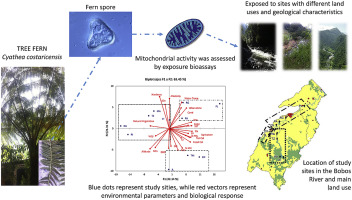当前位置:
X-MOL 学术
›
Chemosphere
›
论文详情
Our official English website, www.x-mol.net, welcomes your feedback! (Note: you will need to create a separate account there.)
Mitochondrial activity in fern spores of Cyathea costaricensis as an indicator of the impact of land use and water quality in rivers running through cloud forests
Chemosphere ( IF 8.8 ) Pub Date : 2017-09-21 , DOI: 10.1016/j.chemosphere.2017.09.094 Alexis Joseph Rodríguez-Romero , Axel Eduardo Rico-Sánchez , Myriam Catalá , Jacinto Elías Sedeño-Díaz , Eugenia López-López
Chemosphere ( IF 8.8 ) Pub Date : 2017-09-21 , DOI: 10.1016/j.chemosphere.2017.09.094 Alexis Joseph Rodríguez-Romero , Axel Eduardo Rico-Sánchez , Myriam Catalá , Jacinto Elías Sedeño-Díaz , Eugenia López-López

|
Early-warning biomarkers, such as mitochondrial activity, have become a key tool in ecosystem assessment. This study aims to evaluate the response of mitochondrial activity in spores of the autochthonous fern Cyathea costaricensis as a bioassessment tool concurrently with land use and physicochemical evaluation in 11 sites along Bobos River, Veracruz, Mexico, to assess river water quality. Bobos River is located in the Nautla basin, northeastern Veracruz (Mexico); the upper river runs through a protected natural area (Filobobos River and adjacent areas). The study involved three monitoring periods: February, June and September 2014. In each study site, physicochemical water quality parameters were recorded to calculate the Water Quality Index (WQI); also, study sites were characterized in terms of land use. Water samples were collected to perform bioassays where spores of C. costaricensis were exposed to samples to assess mitochondrial activity; a positive control exposure test was run under controlled conditions to maximize mitochondrial activity. A Principal Component Analysis was performed to correlate land-use attributes with environmental variables and mitochondrial activity. Three river sections were identified: the upper portion was characterized by the dominance of native vegetation, the highest WQI (in September), and the lowest mitochondrial activity (63.87%–77.47%), related to the geological nature of the basin and high hardness levels. Mitochondrial activity peaked in September (98.32% ± 9.01), likely resulting from nutrient enrichment in the rainy season, and was lowest in February (74.54% ± 1.60) (p < 0.05). Mitochondrial activity was found to be a good benchmark for the assessment of water quality, reflecting the effects of physicochemical characteristics. Mitochondrial activity showed changes along the river and between seasons, associated with environmental characteristics such as land use and the geological nature of the basin, as well as with those related to human impacts.
中文翻译:

Cy木蕨类植物孢子的线粒体活性,作为流经云雾森林河流的土地利用和水质影响的指标
线粒体活动等预警生物标志物已成为生态系统评估的关键工具。本研究旨在评估线粒体蕨类植物Cyathea costaricensis孢子中线粒体活性的反应。在墨西哥韦拉克鲁斯州波波斯河沿岸的11个地点进行生物利用评估,同时进行土地利用和物理化学评估,以评估河流水质。波波斯河(Bobos River)位于韦拉克鲁斯(墨西哥)东北的瑙特拉盆地。上游河流穿过自然保护区(菲洛波博斯河和邻近地区)。该研究包括三个监测时期:2014年2月,6月和9月。在每个研究地点,记录物理化学水质参数以计算水质指数(WQI);同样,研究场地的特点是土地利用。收集水样品以进行生物测定,其中哥氏梭菌的孢子接触样品以评估线粒体活性;在控制条件下进行阳性对照暴露测试,以使线粒体活性最大化。进行了主成分分析,以将土地利用属性与环境变量和线粒体活动相关联。确定了三个河段:上部为原生植被,WQI最高(9月),线粒体活性最低(63.87%–77.47%),与盆地的地质性质和高硬度有关水平。线粒体活性在9月达到峰值(98.32%±9.01),可能是由于雨季的营养富集所致,而2月最低(74.54%±1.60)(p <0.05)。发现线粒体活性是评估水质的良好基准,反映理化特性的影响。线粒体活动显示出沿河和季节之间的变化,这与环境特征(例如土地使用和流域的地质性质)以及与人类影响有关的特征有关。
更新日期:2017-09-21
中文翻译:

Cy木蕨类植物孢子的线粒体活性,作为流经云雾森林河流的土地利用和水质影响的指标
线粒体活动等预警生物标志物已成为生态系统评估的关键工具。本研究旨在评估线粒体蕨类植物Cyathea costaricensis孢子中线粒体活性的反应。在墨西哥韦拉克鲁斯州波波斯河沿岸的11个地点进行生物利用评估,同时进行土地利用和物理化学评估,以评估河流水质。波波斯河(Bobos River)位于韦拉克鲁斯(墨西哥)东北的瑙特拉盆地。上游河流穿过自然保护区(菲洛波博斯河和邻近地区)。该研究包括三个监测时期:2014年2月,6月和9月。在每个研究地点,记录物理化学水质参数以计算水质指数(WQI);同样,研究场地的特点是土地利用。收集水样品以进行生物测定,其中哥氏梭菌的孢子接触样品以评估线粒体活性;在控制条件下进行阳性对照暴露测试,以使线粒体活性最大化。进行了主成分分析,以将土地利用属性与环境变量和线粒体活动相关联。确定了三个河段:上部为原生植被,WQI最高(9月),线粒体活性最低(63.87%–77.47%),与盆地的地质性质和高硬度有关水平。线粒体活性在9月达到峰值(98.32%±9.01),可能是由于雨季的营养富集所致,而2月最低(74.54%±1.60)(p <0.05)。发现线粒体活性是评估水质的良好基准,反映理化特性的影响。线粒体活动显示出沿河和季节之间的变化,这与环境特征(例如土地使用和流域的地质性质)以及与人类影响有关的特征有关。


























 京公网安备 11010802027423号
京公网安备 11010802027423号